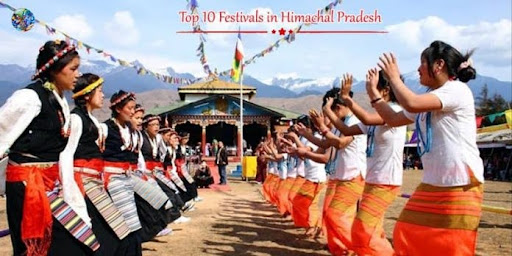Festivals are one way to stay engrossed in matters and find new methods to commemorate life’s events. Throughout the year, numerous galas take place all around the world, mainly in India. While numerous galas are held all around the country, some might be distinct in positive areas. Beginning with January 1, the celebrations start and give up within December, resuming the endless length of celebrations.
Himachal Pradesh, commonly known as the Land of Lords, is home to people from a variety of ethnicities and cultures. Positive galas in Himachal are not uncommon, however.
1. Chet Festival
People outside the neighborhood and indoor areas of Himachal Pradesh confer with this pageant as Dholru and Charlie. It is determined within the country at some point in the primary lunar month. It is called a “signal of happiness” and a “portal to it.” It is considered one of the most famous galas, and those who take part eagerly take part in it.
Festival length: Very 1st day of the lunar month of the lunar year referred to as Dohlru.
Major attractions: Kangra, Hamirpur, and Bilaspur.
2. Losar Pageant
Losar is a festival that honors the start of a new year. Within the country, it is passionately and zealously pursued. The Tibetan colonies also participate in the festivities because they are as important to them. Because the pageant is observed through many masks, dances, and dramas, the locals enjoy in themselves to the maximum. A specialty is the Chham dance. The public is encouraged to participate in the day’s celebrations.
Festival length: Last Week of February of every year
Major attractions: Lahaul district
3. Hariyali
In Lahaul, it’s called Shegtsum, and in Jubbal and Kinnaur, it’s called Dhakhrain. A few days before the pageant, each family member close to the family deities sows seeds of five to seven one-of-a-kind grains collectively in a small basket full of soil. Stems are installed in the door’s upper body and distributed to the family deities.
To this day, farmers no longer yoke oxen. Cow dung balls are used to burn blood-sucking bugs, including lice, bugs, and flees. Wild plant life is used to embellish the village deity in the Kinnaur district. During the pageant, it’s famous for looking at human beings dancing and making songs.
Festival length: Month of Sawan, 16th July
Major attractions: Kangra district and some places in Lahaul
4. Baisakhi
Kangra’s call is Nowowa, Shimla’s call is Bissue, and Pangi’s call is Lisshoo. Arrangements for pageants begin several months before the event. The houses are painted white. Holy baths are taken at Haridwar, Tattapani, close to Shimla, Banganga, close to Kangra, and Markanda, close to Bilaspur. A Baisakhi gala is held in various locations throughout the day, with normal gaiety and appeal. It is the presence of women in large numbers that gives the festive mood a special dimension.
Festival length: 13th of April every month
Major attractions: the border of Himachal Pradesh and Punjab.
5. Jagra
It is one of Himachal Pradesh’s most famous galas, taking place in September. The gala’s most important appeal is the village goddess, who’s worshipped via various means by the villagers. Each village has its own god, which they worship via the means of making songs and dancing to their heart’s content. Mahasu Devta is worshipped in the Shimla, Kinnaur, and Sirmaur areas.
Festival length: Month of September, 4th Sept.
Major attractions: Kinnaur, Sirmaur, and hilly areas.
6. Halada Festival
Several locations in Himachal Pradesh, mainly the Chandra and Bhaga valleys, are enchanted via the pageant. People use mild pencils and skinny cedar sticks to construct a bonfire that rivals, if not surpasses, the opulent Diwali celebration. The bonfire is a vital part of the pageant.
Festival length: Month of December or January every year
Major attractions: Lahaul district of Himachal Pradesh.
7. Nawala
This Nawala pageant is held to thank Lord Shiva for showering his benefits on human beings via the way of shielding them and preserving them from blankets of adversity. Households commonly store cash at some stage in the year, and after they have enough, they rejoice in the pageant via means of staying up all night singing devotional songs and praising Lord Shiva. It is the most well-known pageant among the Kangra, Chamba, Kullu, and Mandis Gaddi tribes.
Festival length: September to October every year
Major attractions: Kangra district
8. Kullu Dussehra
The pageant is widely known with zeal within the country of Himachal Pradesh, with the burning of Ravana’s effigy being a high-quality tradition. That’s then manifested in a single shape or another. Until Diwali arrives, the pageant is marked by the bursting of crackers. The Kullu Dussehra pageant is the most well-known, no longer the most effective within the country, but additionally beyond its borders. Kullu draws traffic from all around the world as people come to revel in the pageant.
Festival length: In October every year
Major attractions: Kullu and all over Himachal Pradesh.
9. Lohri
Lohri is a pageant. This is broadly determined in Himachal Pradesh. The pageant lasts for 8 days, which represents the beginning of the festivities. It is observed by means of track and dance performances. Along with the Lohri loot, this is nevertheless famous amongst children; the Lohri track remains the primary appeal.
Festival length: During the first half of January
Major attractions: Border of Himachal Pradesh and Punjab also in Shimla
10. Chrewal
In a few areas, it’s additionally called “Prithvi pooja.” This is going on for the entire month. During this month, farmers no longer yoke oxen. Badranjo is the name given to this pageant in Kullu. Pathroru is the name given to it in Chamba. There’s a flower pageant in this town. This is a joyous day, especially for the ladies who dance on this day.
Festival length: 1st of Bhadun withinside the mid of august.
Major attractions: Chamba district of Himachal Pradesh.
Conclusion
These are the galas that people in Himachal Pradesh look forward to at some point during the year in order to have the opportunity to approach God and express love and affection. God and Goddess play a significant role in each of the galas, despite the fact that they are held in an unusual venue. At such gatherings, people usually celebrate to thank God for his blessings and show thankfulness.




